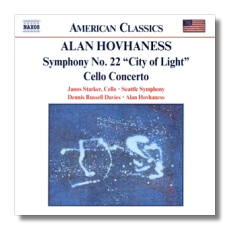
The Internet's Premier Classical Music Source
Related Links
- Latest Reviews
- More Reviews
-
By Composer
-
Collections
DVD & Blu-ray
Books
Concert Reviews
Articles/Interviews
Software
Audio
Search Amazon
Recommended Links
Site News
 CD Review
CD Review
American Symphonies

David Diamond
- Psalm (1936)
- Kaddish for Cello and Orchestra (1987) *
- Symphony #3 (1945)
* János Starker, cello
Seattle Symphony Orchestra/Gerard Schwarz
Naxos 8.559155


Alan Hovhaness
- Concerto for Cello and Orchestra, Op. 17
- Symphony #22 "City of Light", Op. 236
* János Starker, cello
* Seattle Symphony Orchestra/Dennis Russell Davies
Seattle Symphony Orchestra/Alan Hovhaness
Naxos 8.559158
Both these discs are part of Naxos' ongoing American Music Series and launch the label's first recordings with the Seattle Symphony Orchestra. The Diamond disc was first issued a decade or so ago on a more expensive Delos disc but with the added substantial filler of Roméo and Juliet. (Yes, Diamond wrote music for that Shakespeare tragedy, too!). The Hovhaness Symphony #22 was also previously issued on Delos, but the Cello Concerto, taped in March, 1999, is a première release not only of the performance but of the work itself. I had obtained the Delos/Diamond disc in the early 1990s, along with several others in that label's Diamond series, a mostly successful undertaking, at least from an artistic point of view.
Diamond at one time was overshadowed not only by Hovhaness but by Copland, Barber, Menotti, Harris, Bernstein and other American composers. Hovhaness and Harris have faded somewhat, but Diamond has grown in stature, deservedly so. He should be ranked with the most important American composers of the 20th century. Incidentally, he is still alive and apparently still writing music as I write this in the spring of 2003.
Both the shorter works on the Diamond disc are excellent, Psalm coming across as a powerful and atmospheric early work, perhaps not on the level of the others here though. Kaddish (a Hebrew prayer for the dead) is a moving, dark work, which Starker and Schwarz render with passion and utter commitment. But it is the Symphony #3, completed in 1945, that is the major work on the disc, and it is one of my favorite Diamond scores.
The first movement brims with muscular energy and vibrant color. It features a main theme whose first three notes serve as a sort of motto throughout – those three notes are, by the way, quite similar in sound and effect to the driving motif in the finale of Prokofieff's Seventh Sonata, also a wartime work. The ensuing Andante is lovely in its tense lyricism, and the Allegro vivo third movement is colorful and humorous in its effervescence and vitality. The Adagio assai finale is touchingly mournful, with imaginative and lovely scoring for clarinet and oboe. The Seattle players and conductor Schwarz turn in committed work, and it would be hard to imagine a better performance than this one appearing in the near future. I only wish Naxos had toned down the thumping drum sonorities that Delos had captured in the original recording sessions. Still, the sound is excellent and so is this disc.
As for the Hovhaness issue, I was at first taken by the 1936 Cello Concerto, a work which the composer allowed to survive after destroying many of his earliest compositions. It features a quite attractive, somewhat exotic main theme that immediately catches the ear. But, alas, the instrumentation is rather barren, often with only a single line sounding, usually the cello or flute playing unaccompanied. Moreover, the thematic material is not plentiful enough for the nearly sixteen minutes this movement consumes. That said, the music has many beautiful moments in this recording, and the brief second movement offers a good measure of charm and color. The finale also features fine music, though it too may stretch its modest materials a bit too far as well. Again, the main theme has strong appeal and the music is quite effectively atmospheric throughout.
Starker plays the work brilliantly, and Schwarz and the Seattle players make about the best case possible for this score. But it is the 1971 Symphony #22 that is the more important work here, and the listener will find it quite attractive. The intensity of the lyrical outpouring in the latter half of the first movement alone makes this symphony worthwhile. But the lovely Largo that follows, subtitled 'Angel of Light', and the ensuing Allegretto grazioso, based on music the composer had written in his teens for an operetta, are also colorful and feature some of Hovhaness' trademark exoticism. The Largo maestoso finale, at thirteen minutes, is the longest movement. It is quite compelling in its majestic main theme and colorful instrumentation, but it may be a bit overlong too, though the ending is powerful and brilliantly colorful. Overall then, this is a fine work, and the Seattle Symphony, under the composer's insightful direction, turn in a splendid, spirited performance. Again, the sound is excellent and this disc can be heartily recommended to Hovhaness and American music enthusiasts. By the way, the composer revealed that he had imagined a city of a million lights when he was composing this work, and thus gave it the 'City of Light' subtitle.
Copyright © 2003, Robert Cummings


















